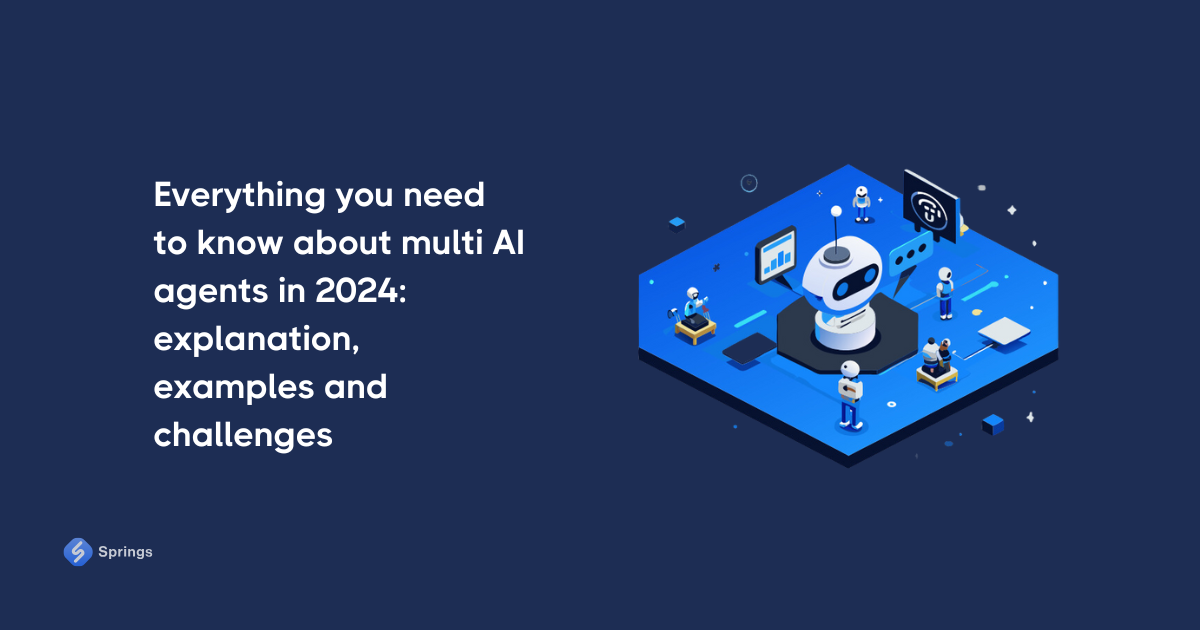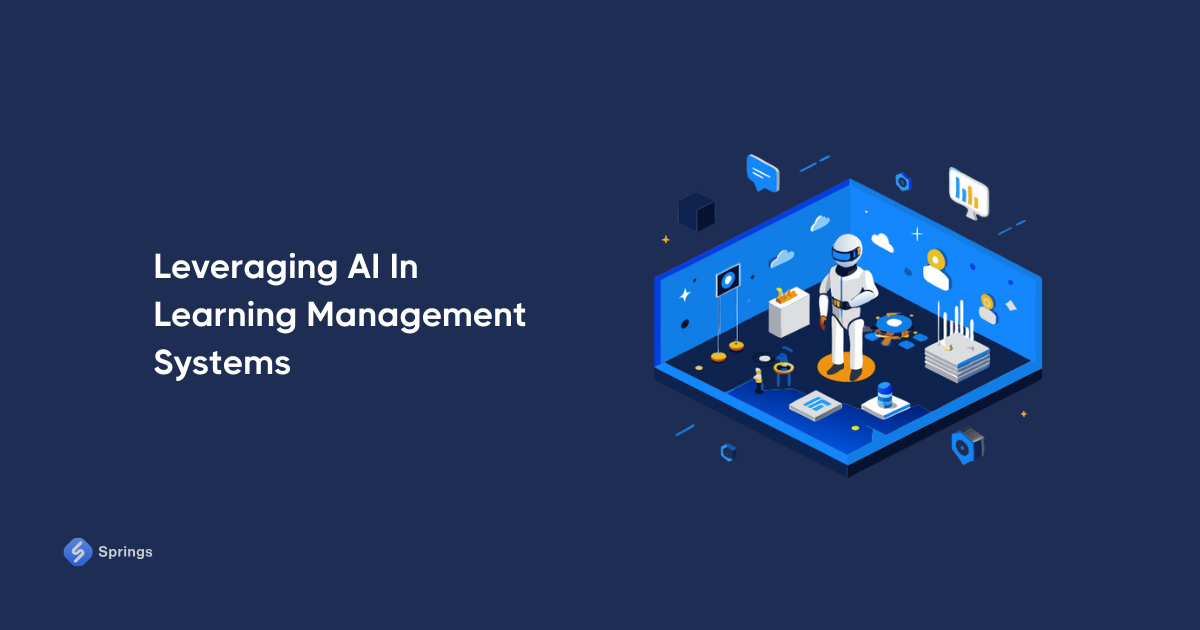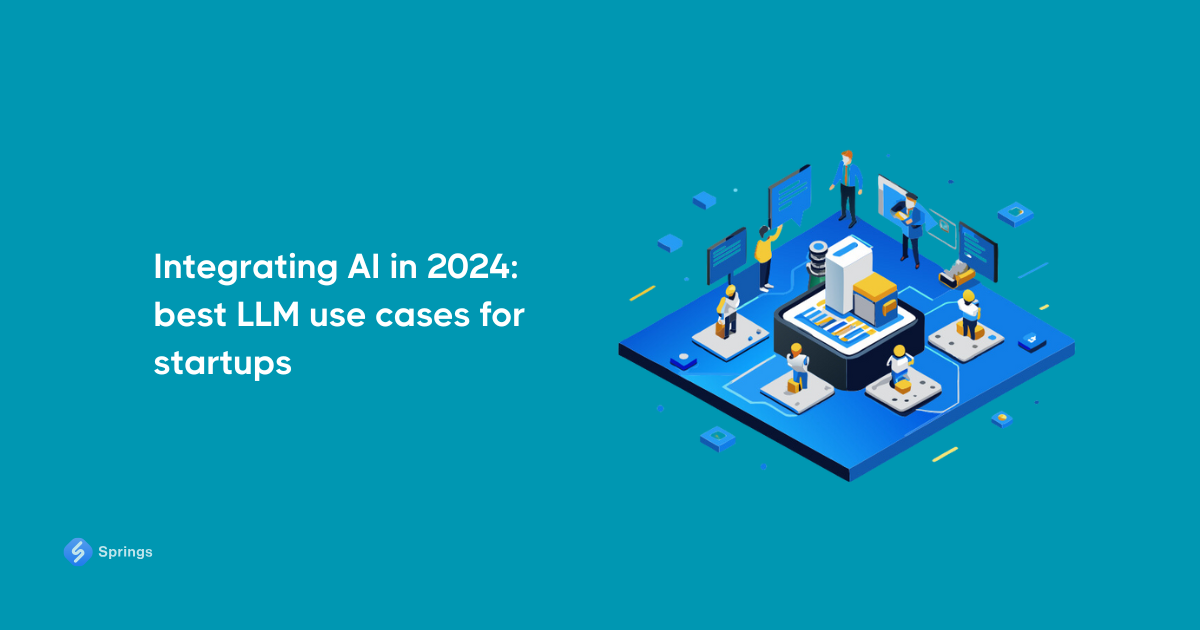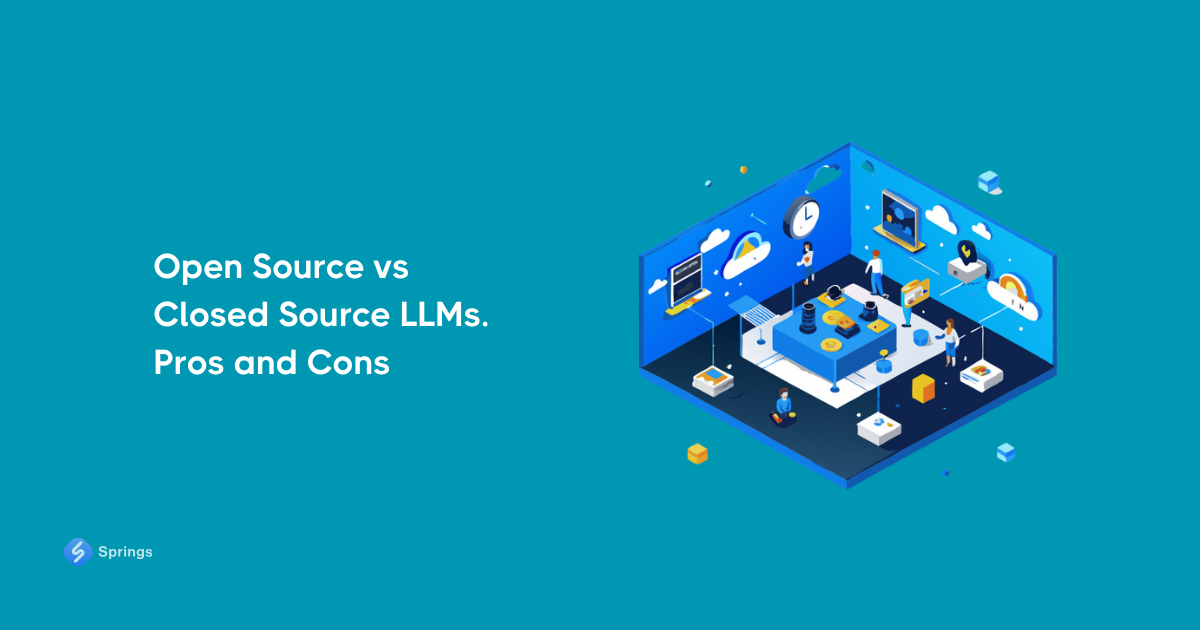AI Development Cost In 2024: Real Examples And Trends
The market of AI-based products will continue to grow in 2024. Last year, companies spent $154 billion on these solutions. Despite the impressive figures, not all enterprises are eager to adopt these tools. One of the main reasons for this behavior is the perceived astronomical cost of AI development that nobody can afford.
While some projects cost considerable time and resources to adopt, making AI tools isn’t as costly as some try to make it. We want to explain why businesses explore these solutions, the main price-setting factors, how to reduce them, and the cost of some projects we developed over the years.
Why Companies Invest In AI Development
Businesses have different reasons for investing in AI solutions. Their decision can be influenced by the industry they work in, company size, goals, and challenges. However, there are several significant factors that push them to develop these tools.
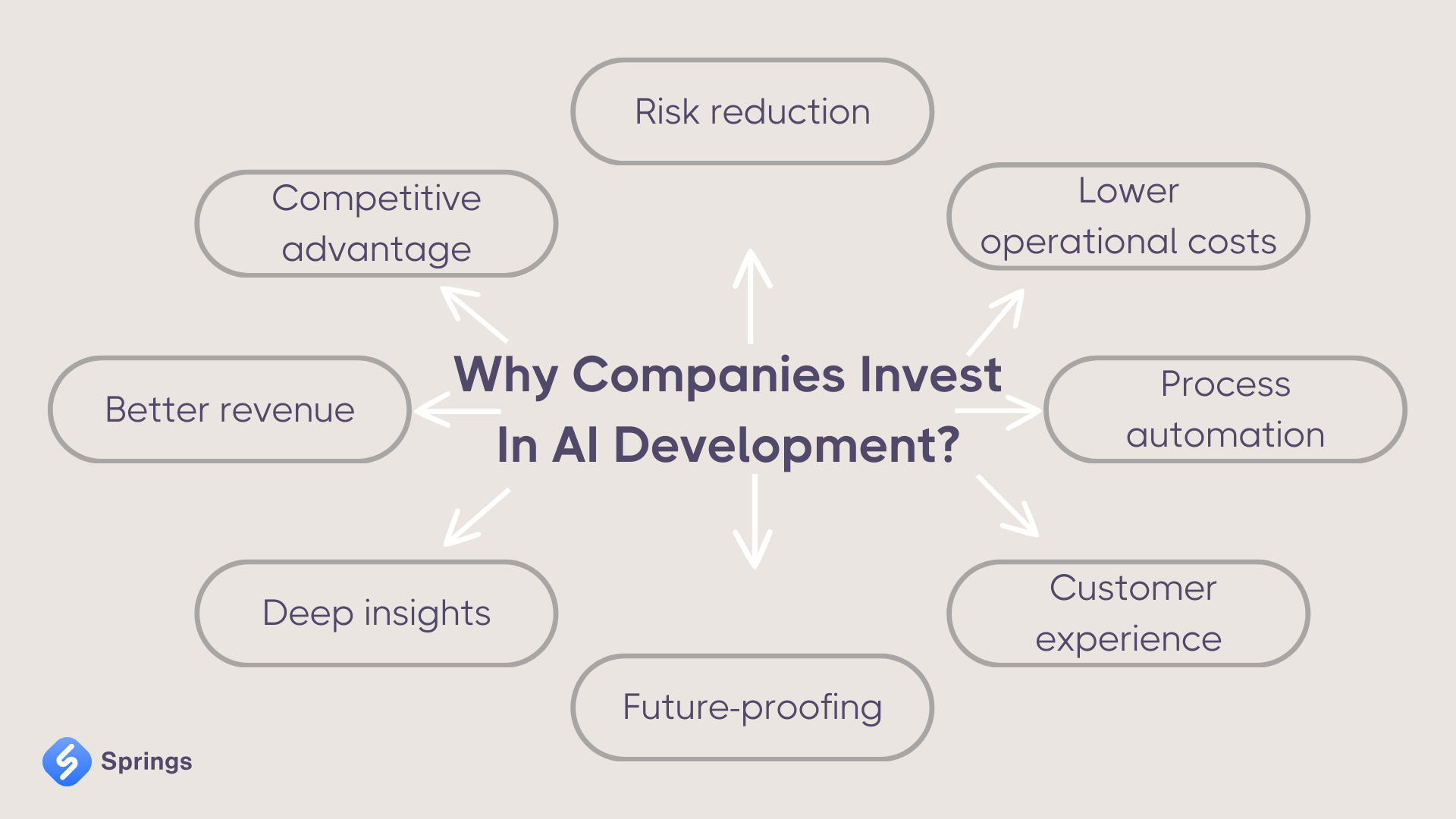
- Competitive advantage. One of the main things companies wish to achieve with AI is a better chance of beating the competition. Modern customers expect fast issue resolution, which becomes a significant factor in client growth and retention.
- Better revenue. Many enterprises use AI products to run their marketing campaigns more efficiently. These tools offer a level of personalization unattainable through regular means as they have instant access to complete customer history.
- Deep insights. Some AI tools have powerful analytical capabilities to spot patterns and trends humans can overlook. They help businesses make more informed decisions, improve products, and plan daily operations.
- Future-proofing. AI is becoming a critical factor in running a successful business by the day. Companies often invest in these products to keep up with the latest tech trends and ensure they can compete in a changing landscape.
- Enhanced customer experience. One of the main driving factors behind rapid AI adoption is the ability of these tools to enhance the buyer experience. They achieve this through tailored interactions, recommendations, and bonuses.
- Improved process automation. Modern AI solutions help reduce the staff workload and streamline operations that previously required a human touch. They handle customer support, logistics, inventory management, employee identification, and other processes.
- Lower operational costs. Despite the financial expenses associated with AI development, businesses often make them to reduce costs in the long run. Thanks to their versatility, these products almost entirely replace entire departments, reducing the need to pay healthcare insurance, salaries, maternity leaves, and other recurring costs.
- Risk reduction. With AI solutions, enterprises proactively reduce risks in many areas. These tools help identify fraud, find security vulnerabilities, evaluate market trends, and even predict product malfunctions.
Factors Influencing The Cost Of AI Development
The cost of AI tools requires several factors to calculate correctly. They help businesses better balance the development budget and calculate fees associated with this process.
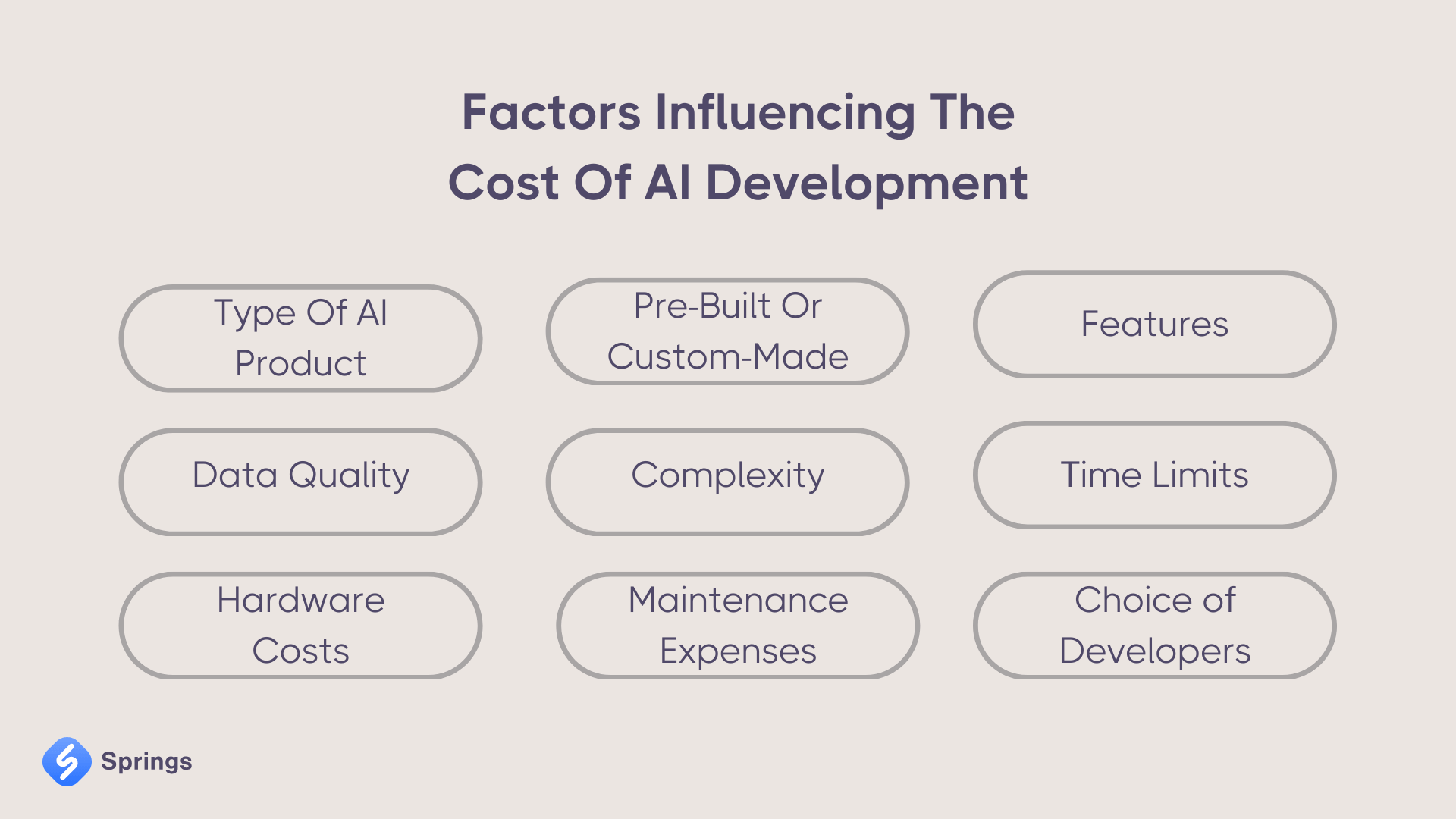
Type Of AI Product
One critical factor that adds to the cost of the AI-based solution is the type the firm wants to get. These products aren’t restricted to generative tools like chatbots and virtual assistants. Businesses can develop solutions using the following AI technologies:
- Image recognition. This tech allows AI products to identify and classify objects in static images and video feeds and is widely used in healthcare diagnostics and security.
- Prediction. With its help, forecast events and behavior based on historical data, making them ideal for marketing and financial use.
- Fraud detection. AI tools can uncover unusual activity patterns and potential fraud with broad applications in the security and financial sectors.
- Speech recognition. Programmers can introduce this technology to allow employees and customers to interact with different products via voice. It’s widely popular among the e-commerce and retail sectors.
- Recommendations. It’s possible to equip software solutions with recommendation systems to suggest products, services, or content. Streaming services and SM platforms use this technology in their daily work.
On average, the less complex AI products are less expensive to build. For example, a chatbot is more accessible to produce than an image recognition system that’s paired with CCTV equipment to find masked and unmasked restaurant customers.
Pre-Built Or Custom-Made
Another aspect capable of raising AI development pricing is the type of project the company wants to implement. Off-the-shelf solutions are cheaper to develop but may lack enterprise-specific features. In this case, a business only needs to worry about integration expenses and ongoing fees.
Custom-made products are more costly since they require building and training from scratch. This increases development time, which can spell trouble if a business is in a hurry to cater to customers or cover internal requirements. However, they’re better at addressing business specifications and goals.
Features
Even a conversational chatbot can cost a lot. In addition to text input capabilities, these solutions can support speech-to-text and image search operations. Depending on business goals, it's possible to equip them with analytical capabilities, such as customer trends evaluation or sentiment analysis.
The same is true for other types of AI products. For example, an inventory solution for an e-commerce store can be equipped with predictive analysis. This component allows it to manage stock levels based on buyer and seasonal trends automatically. The more features they will have, the more companies should expect to spend.
Data Quality
The effectiveness of AI solutions is directly linked to the amount and quality of data. Developers use this information to train and fine-tune products to perform various tasks. These factors affect programming costs as properly collecting, preparing, and organizing this information takes time and effort. Modern AI tools use structured and unstructured data to learn how to function.
Experts have to take some time to organize and label the second type. This concerns information found in emails, videos, or images. In medical and financial spheres, some of this data can be kept private, meaning that software engineers have to go the extra mile and find information that doesn’t jeopardize people and provides adequate training.
Complexity
Another factor that can increase AI development costs is the environment in which the solution will operate. Products that will be available across all business platforms are more costly than those developed for a single communication channel like a messenger app or a website.
AI solutions almost always require integration with other programs and systems. For example, a medical chatbot can be paired with administrative software to schedule appointments. Some of these systems use outdated software, requiring more time and effort to understand how to pair them correctly through frameworks or APIs.
Time Limits
Businesses don’t have all the time in the world to make AI products. In many cases, they have problems that affect their daily profits, which these solutions can address. Project deadlines become an essential factor in the final price of these tools.
The more complex a tool is and the faster it should be deployed, the more companies will spend on its programming. They must balance speed, features, and data volumes. Otherwise, enterprises can quickly descend into endless development.
Hardware Costs
Hardware fees are another factor that influences the development costs of AI solutions. Whether a company chooses to make a product on its own or get one from a third-party vendor, it still needs somewhere to run the tool. These solutions require a lot of computing power for data analysis and processing.
The enterprise must establish a proper infrastructure that will help handle user volumes and provide fast responses. For more wealthy enterprises, this means spending resources and setting up server infrastructure. However, less sizable businesses may choose cloud services if the nature of their AI products allows this approach.
Maintenance Expenses
When it comes to AI products, the costs of their implementation don’t end post-release. There must be someone to check the accuracy of these solutions if they work as intended or if customers or employees experience issues with their use. Otherwise, all of the previous work will be pointless.
These management and maintenance fees can be paid to in-house teams or outside firms. In many cases, post-release support comes with the AI tools. To make these expenses more manageable, companies can work on maintenance on their own, but getting employees to know the intricacies of these solutions may take some time.
Choice of Developers
Finally, the cost of AI development is directly linked to the choice of experts working on it. The current market of AI development firms has over 67,200 businesses that cater to enterprise needs. Some offer fixed prices on their tools, while others have a flexible scale. Their price range can also be all over the place, making it hard for businesses to plan their budgets.
Estimated Costs Of AI Products In 2024
Regarding AI solutions, there are no fixed prices for chatbots or other tools. The abovementioned factors can cause their total price to range from thousands to hundreds of thousands of dollars. To make things a bit clearer, here are several price tags enterprises can expect from differently-sized projects:
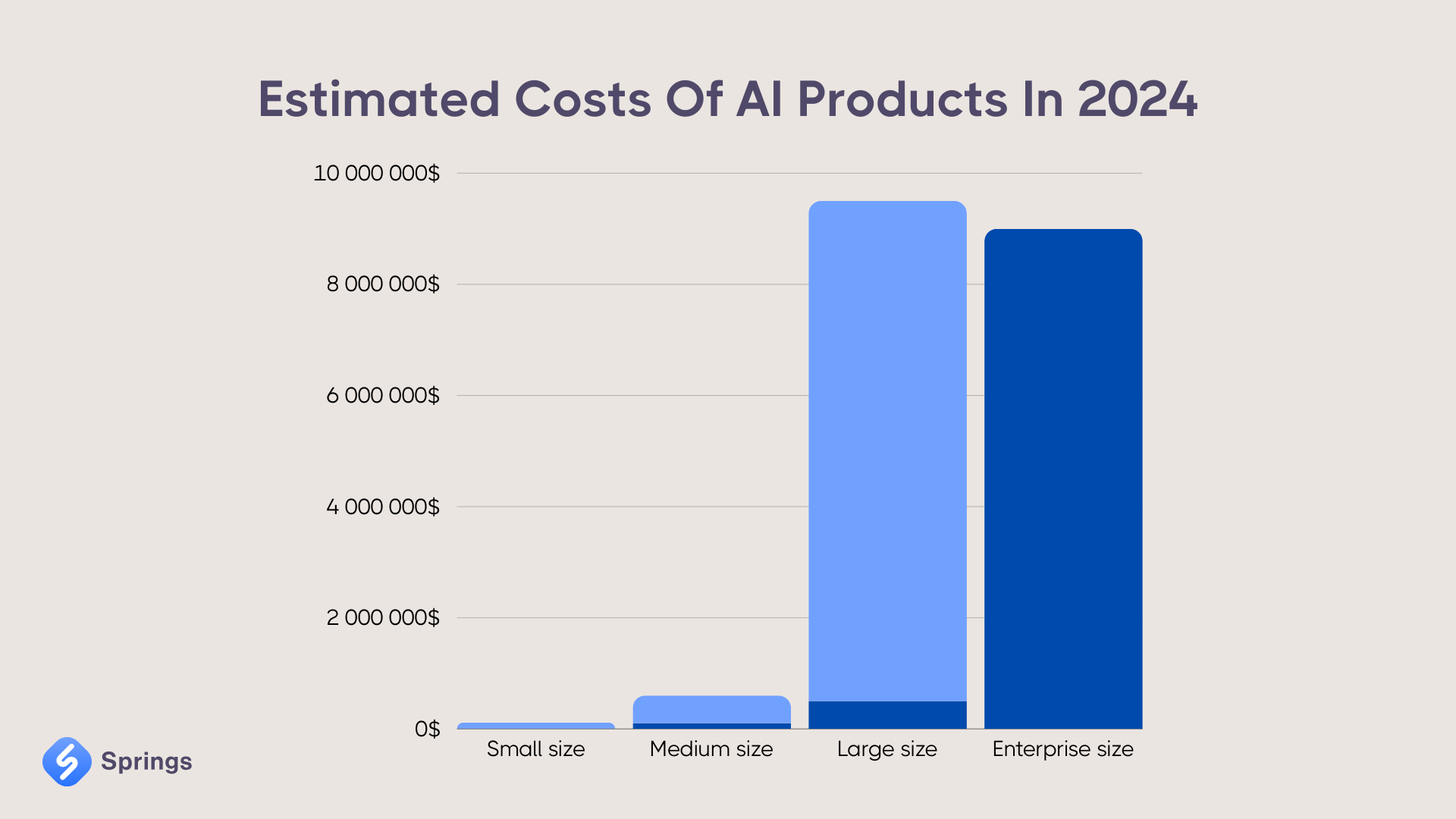
Small size: $10,000 to $100,000.
Medium size: $100,000 to $500,000.
Large size: $500,000 to $9,000,000.
Enterprise size: Over $9,000,000.
These figures may sound daunting but remember that we’re talking about a multibillion-dollar industry. We doubt that an average-sized company will ever have spent this much. This rarely happened in our practice, which is what the next segment is about.
AI Development Pricing: Springs Case Studies
Springs has already delivered different AI solutions and we are happy to share some budget information about them.
AI Booking Helper
MVP Budget: 6000$
Phase 2 Budget: 7500$
Springs engineers developed an AI-based Chrome Extension that allows users to create instant meetings and schedule appointments on their calendars.
The client approached us with a request to create a Google Chrome browser extension integrated with their existing AI-powered meeting management tool, similar to Google Meet. The client's platform aimed to offer users an enhanced meeting experience with additional AI features.
The product we developed had a significant impact on our client's meeting management platform and its user base. The results achieved included:
Enhanced User Experience: The Chrome extension added flexibility and convenience to the existing platform, making it more user-friendly. Users could now access their accounts, schedule meetings, and access advanced features with ease.
Expanded User Base: The improved functionality attracted new users to the core client's platform. Existing users also benefited from the added convenience, leading to increased user satisfaction and retention.
Competitive Edge: With the Chrome extension in place, startup gained a competitive advantage in the market. While competitors also offered extensions, our client's enhanced extension further solidified their position as a leader in AI-powered meeting management.
AI Chatbot Builder
MVP Budget: 14000$
Phase 2 Budget: 25000$
IONI is an AI Chatbot Builder with an integrated Generative AI algorithm that analyzes provided data and returns necessary information requested by the user. There are many values that IONI can give your business, such as:
Efficient Customer Support: IONI's AI Chatbot Builder streamlines customer support by swiftly analyzing data and providing users with the requested information, ensuring quick and efficient responses to their inquiries.
Enhanced User Experience: With an integrated Generative AI algorithm, IONI elevates the user experience by offering accurate and relevant information, fostering positive interactions and satisfaction.
Time and Resource Savings: By automating information retrieval, IONI helps businesses save time and resources, allowing them to allocate their workforce more effectively and focus on strategic initiatives.
IONI offers a time-saving and effortless template management feature, empowering support teams to streamline their processes. This enhancement not only optimizes customer service efficiency but also liberates agents to concentrate on higher-value tasks, resulting in an enriched customer experience.
AI Computer Vision Scanner
MVP Budget: 13000$
Phase 2 Budget: 22000$
Phase 3 Budget: 37000$
Springs team developed a tailor-made solution for the optimization of receiving processes on the large transshipping warehouse for the logistics provider.
The solution comprises two primary components: the Computer Vision ML Tool and the AI Web Application. At the heart of this solution lies a customized Warehouse Management System (WMS) module designed to streamline critical operations within the facility. This module harnesses the power of strategically positioned cameras, eliminating the fish-eye effect. Its core functionalities encompass two key tasks:
Label Recognition and Processing. The Computer Vision Tool efficiently recognizes and processes labels, reducing the need for manual intervention.
Generation and Printing of Unified Labels. It takes charge of generating and printing standardized labels throughout the facility, ensuring consistency and precision.
In summary, the integration of this module not only yielded cost savings and risk reduction but also underscored the importance of dataset preparation and machine learning training to achieve high-accuracy text recognition and efficient database matching.
How To Reduce AI Development Costs
Companies sometimes get carried away with AI projects, especially if they never made one. The urge to have the solution be a one-man army can increase development costs past the initial budget. Businesses can use the following tips to keep things under control and reduce expenses.
- Identify the main use cases. Companies can significantly reduce AI development pricing by establishing their main problems and determining how the tools can solve them. For example, if they need a customer support conversational tool, there’s no need to equip it with image search.
- Use freely available technology. Businesses should work with open-source technologies such as large language models to avoid paying additional fees. Using freely available tools and components significantly decreases final costs.
- Prepare the data beforehand. Additionally, it's crucial to gather, clean, and prepare the necessary information the solution may require. This will speed up the development process and leave more time to finetune solutions.
- Create an MVP version. Enterprises must create a test version of the proposed AI tool to check if it's worth the further work. At this point, it's possible to find out that you don’t need a product or that it’s the solution you’ve needed for years.
- Calculate infrastructure and operational costs. When exploring AI development options, enterprises must establish how much they’re willing to pay for ongoing support and hosting, as well as explore different providers of these services.
Remember that AI integration is a continuous process. Enterprises should continuously gather user feedback and monitor how the solution works long after deployment. This approach helps pinpoint drawbacks before they become an issue and save on reputational costs.
Conclusion
Exploring AI development options is a crucial step in modernizing any business. We hope our article will help enterprises better balance the costs and rewards of making these solutions and save on expenses. If you have a solution idea and need someone to help adjust its features, call us for a free consultation.

